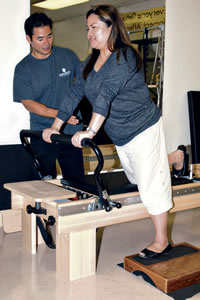
Treating That Aching Back
August 31, 2011
By Ken Morimoto


Ken Morimoto, DPT
Physical therapist at Rehabilitation Hospital of the Pacific in Aiea
Where did you receive your schooling and training?
I attended Oregon State University, where I received a Bachelor of Science degree. For my doctorate in physical therapy, I went to A.T. Still University.
How long have you been practicing?
About four-and-a-half years.
{embed=“elements/box_ad”}
What demographic do you primarily see when it comes to back ailments?
Patients are about 50 percent male and 50 percent female, with ages ranging from adolescent to geriatric, and they come to us for various diagnoses. I would say the majority of patients are in their 30s and up.

|
Any particular problem you mostly see?
Low position too long. In addition, poor ergonomics and posture while sitting may lead to increased stress along the lumbar spine.
How do you go about treatment planning?
On the first session, we do a thorough evaluation. Based on the evaluation, we design an individualized home program. One of our main goals with physical therapy is that the patient take initiative and responsibility for their injury, so they are required to perform exercises regularly at home.
Can you talk about the kind of treatment options you would recommend for disc problems vs. deskrelated issues?
Initially, the patient completes a subjective evaluation, which enables us to identify their functional problems what makes them feel better and what the aggravating factors are. For an evaluation of the back, there’s a standard form that we follow. We then do specialized tests to differentiate if the injury is discular, facet, arthritic or muscular in origin. We differentiate our diagnosis through special tests and the questions we ask.
When someone has a “disc” problem, what does that mean?
Two common problems are a bulging disc and a herniated disc. There are four different types of herniations: protrusion, prolapse, extrusion and sequestration. The most severe is the sequestration, in which there is myelopathy or pressure on the nerve roots. Depending on the severity and type of herniation, our goal in physical therapy is to centralize symptoms and then minimize the pain.

|
What kind of tissue makes up a disc?
It’s a jelly-like substance, like a jelly doughnut. The outer ring is what we call the annulus fibrosus, and the inner ring or the jelly is called the nucleus pulposis. These discs are located between the spinal vertebrae and provide space and cushioning.
As we get older, these discs gets smaller primarily because of the physical properties of the disc. These discs lose water content and therefore become smaller and less pliable. This explains the reason why as we get older we can actually become shorter. As the discs become thinner the vertebrae begin to approximate, thus leading to arthritis or degenerative disc disease. The medical term is spondylosis.
Have there been any major changes in physical therapy methods over the past few years?
I believe treatment today is not only directly aimed at the body. There are other components in getting the patient better. I really believe in the holistic model that is, focusing on the mind, body and spirit to achieve a patient’s goals. In the physical therapy profession, our scope of practice is evidence-based.
{embed=“elements/google_ad336x280”}
Anything else you’d like to mention about your practice?
Here at REHAB at Aiea in Pearlridge Center Phase II, we make use of various equipment such as weight machines, theraband and physioballs. We also have a Pilates reformer. In addition, we have a therapist who’s trained and certified in a manual technique called the McKenzie Method, which is very successful for people with low back injuries. Lastly, at REHAB at Aiea we offer multi-disciplinary services including physical therapy, occupational therapy and speech therapy so that the total person can be addressed.